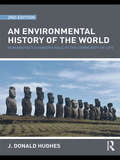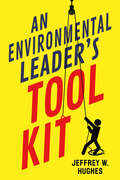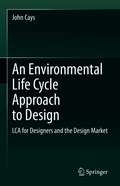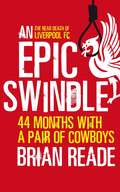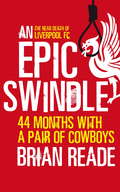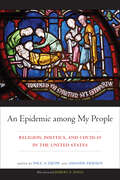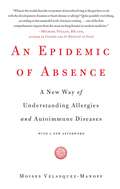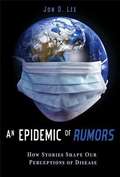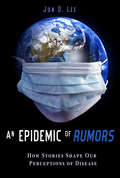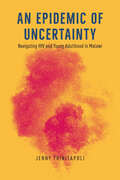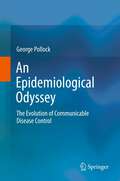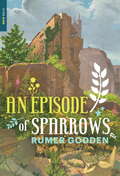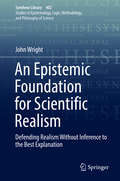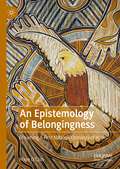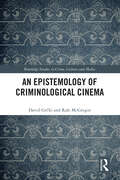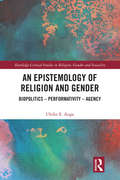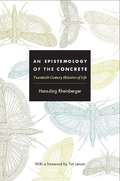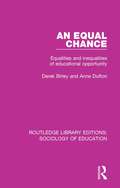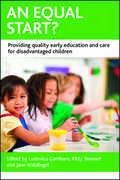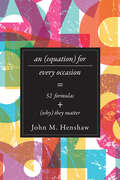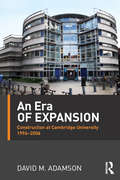- Table View
- List View
An Environmental History of the World: Humankind's Changing Role in the Community of Life
by J. Donal Hughes J. Donald HughesThis second edition of An Environmental History of the World continues to present a concise history, from ancient to modern times, of the interactions between human societies and the natural environment, including the other forms of life that inhabit our planet. Throughout their evolutionary history, humans have affected the natural environment, sometimes with a promise of sustainable balance, but also in a destructive manner. This book investigates the ways in which environmental changes, often the result of human actions, have caused historical trends in human societies. This process has happened in every historical period and in every part of the inhabited earth. The book is organized into ten chapters. The main chapters follow a chronological path through the history of mankind, in relationship to ecosystems around the world. The first explains what environmental history is, and argues for its importance in understanding the present state of the world's ecological problems. Chapters two through eight form the core of the historical analysis, each concentrating on a major period of human history (pre-civilized, early civilizations, classical, medieval, early modern, early and later twentieth century, and contemporary) that has been characterized by large-scale changes in the relationship between human societies and the biosphere, and each gives several case studies that illustrate significant patterns occurring at that time. The chapters covering contemporary times discuss the physical impacts of the huge growth in population and technology, and the human responses to these problems. Our moral obligations to nature and how we can achieve a sustainable balance between technology and the environment are also considered. This revised second edition takes account of new research and the course of history containing new sections on global warming, the response of New Orleans to the hurricanes Katrina and Rita, and the experience of the Dutch people in protecting their low-lying lands against the encroachments of rivers, lakes, and the North Sea. New material is also offered on the Pacific Islands, including the famous case of Easter Island. This is an original work that reaches further than other environmental histories. Rather than looking at humans and the environment as separate entities, this book places humans within the community of life. The relationship between environmental thought and actions, and their evolution, is discussed throughout. Little environmental or historical knowledge is assumed from the reader in this introduction to environmental history. We cannot reach a useful understanding of modern environmental problems without the aid of perspective provided by environmental history, with its illustrations of the ways in which past decisions helped or hindered the interaction between nature and culture. This book will be influential and timely to all interested in or researching the world in which we live.
An Environmental History of the World: Humankind's Changing Role in the Community of Life (Routledge Studies In Physical Geography And Environment Ser. #Vol. 2)
by J. Donald HughesThis second edition of An Environmental History of the World continues to present a concise history, from ancient to modern times, of the interactions between human societies and the natural environment, including the other forms of life that inhabit our planet. Throughout their evolutionary history, humans have affected the natural environment, sometimes with a promise of sustainable balance, but also in a destructive manner. This book investigates the ways in which environmental changes, often the result of human actions, have caused historical trends in human societies. This process has happened in every historical period and in every part of the inhabited earth. The book is organized into ten chapters. The main chapters follow a chronological path through the history of mankind, in relationship to ecosystems around the world. The first explains what environmental history is, and argues for its importance in understanding the present state of the world's ecological problems. Chapters two through eight form the core of the historical analysis, each concentrating on a major period of human history (pre-civilized, early civilizations, classical, medieval, early modern, early and later twentieth century, and contemporary) that has been characterized by large-scale changes in the relationship between human societies and the biosphere, and each gives several case studies that illustrate significant patterns occurring at that time. The chapters covering contemporary times discuss the physical impacts of the huge growth in population and technology, and the human responses to these problems. Our moral obligations to nature and how we can achieve a sustainable balance between technology and the environment are also considered. This revised second edition takes account of new research and the course of history containing new sections on global warming, the response of New Orleans to the hurricanes Katrina and Rita, and the experience of the Dutch people in protecting their low-lying lands against the encroachments of rivers, lakes, and the North Sea. New material is also offered on the Pacific Islands, including the famous case of Easter Island. This is an original work that reaches further than other environmental histories. Rather than looking at humans and the environment as separate entities, this book places humans within the community of life. The relationship between environmental thought and actions, and their evolution, is discussed throughout. Little environmental or historical knowledge is assumed from the reader in this introduction to environmental history. We cannot reach a useful understanding of modern environmental problems without the aid of perspective provided by environmental history, with its illustrations of the ways in which past decisions helped or hindered the interaction between nature and culture. This book will be influential and timely to all interested in or researching the world in which we live.
An Environmental Leader's Tool Kit
by Jeffrey W. HughesIf you want to tackle an environmental problem in your neighborhood but do not know where to start, An Environmental Leader's Tool Kit can help. In this handbook, Jeffrey W. Hughes shares the proven strategies you need to step up and get meaningful action done.From designing a pilot study to managing contentious public meetings and more, Hughes walks you through the essentials of effective place-based environmental efforts. Among the tools you will find here are worksheets to kickstart brainstorming, appendixes that demystify jargon you might encounter, and illuminating, real-life examples. Down-to-earth and stimulating, An Environmental Leader's Tool Kit is a launchpad for those ready to make a difference now.
An Environmental Life Cycle Approach to Design: LCA for Designers and the Design Market
by John CaysThis book introduces readers to Life Cycle Approach (LCA)-supported design solutions, through non-geometric-data-driven methodologies, to provide a clear picture of how to optimize individual designs in addressing ecological challenges. By offering LCA, the book gives designers a complimentary set of science-based perspectives and techniques with a focus on high data quality for clarity and public accessibility. While most design solutions and resources are meant to appeal to people by solving everyday problems, this book uses LCA designs to appeal to people through a combination of practicality, accuracy, and the need to decelerate ecological destruction through products offered to marketplace consumers. In essence, the book teaches designers how to craft environmentally responsive designs for their clients at little to no extra cost, but with necessary ecological benefits. The book analyzes the human desire for consumption, and suggests design innovations for promoting "best practices". LCA tools, data, and methodologies are explained and offered as these potential innovations for affecting positive environmental change. As an underlying component of LCA, the book defines the energy essentials related to environmental problems, and how LCA design solutions must address these factors while also appealing to a designated client-base. The book also teaches designers how to consider corporate incentives for trusting LCA designs, such as investor confidence, loyalty, and consumer trust. The book will appeal to a broad range of designers interested in sustainable and data-driven design, and may be utilized by non-LCA specialists in expanding their design perspectives and goals in the marketplace.
An Epic Swindle
by Brian ReadeAN EPIC SWINDLE is the inside story of how Liverpool FC came within hours of being re-possessed by the banks after the shambolic 44-month reign of American owners Tom Hicks and George Gillett. It is the tale of a civil war that dragged Britain's most successful football club to its knees, through the High Court and almost into administration. Players Steven Gerrard and Jamie Carragher tell of their anger at the broken promises, as well as their pain at watching loyal fans in open revolt. Manager, chief executive, board members, leading fans and journalists reveal the turmoil at a revered sporting institution run by two men at war with each other, who trampled Liverpool's cherished traditions into the gutter. No story sums up the naked greed at the heart of modern football quite like Hicks' and Gillett's attempt to turn a buck at Liverpool. No-one has had as much access to the truth, or tells it with as much passion, wit and insight as Brian Reade. bAN EPIC SWINDLE is the riveting story of how close one of the great football clubs came to financial implosion. b
An Epic Swindle: 44 Months with a Pair of Cowboys
by Brian ReadeAN EPIC SWINDLE is the inside story of how Liverpool FC came within hours of being re-possessed by the banks after the shambolic 44-month reign of American owners Tom Hicks and George Gillett. It is the tale of a civil war that dragged Britain's most successful football club to its knees, through the High Court and almost into administration. Players Steven Gerrard and Jamie Carragher tell of their anger at the broken promises, as well as their pain at watching loyal fans in open revolt. Manager, chief executive, board members, leading fans and journalists reveal the turmoil at a revered sporting institution run by two men at war with each other, who trampled Liverpool's cherished traditions into the gutter. No story sums up the naked greed at the heart of modern football quite like Hicks' and Gillett's attempt to turn a buck at Liverpool. No-one has had as much access to the truth, or tells it with as much passion, wit and insight as Brian Reade. AN EPIC SWINDLE is the riveting story of how close one of the great football clubs came to financial implosion.
An Epic Swindle: 44 Months with a Pair of Cowboys
by Brian ReadeAN EPIC SWINDLE is the inside story of how Liverpool FC came within hours of being re-possessed by the banks after the shambolic 44-month reign of American owners Tom Hicks and George Gillett. It is the tale of a civil war that dragged Britain's most successful football club to its knees, through the High Court and almost into administration. Players Steven Gerrard and Jamie Carragher tell of their anger at the broken promises, as well as their pain at watching loyal fans in open revolt. Manager, chief executive, board members, leading fans and journalists reveal the turmoil at a revered sporting institution run by two men at war with each other, who trampled Liverpool's cherished traditions into the gutter. No story sums up the naked greed at the heart of modern football quite like Hicks' and Gillett's attempt to turn a buck at Liverpool. No-one has had as much access to the truth, or tells it with as much passion, wit and insight as Brian Reade. AN EPIC SWINDLE is the riveting story of how close one of the great football clubs came to financial implosion.
An Epidemic among My People: Religion, Politics, and COVID-19 in the United States (Religious Engagement in Democratic Politics)
by Paul A. Djupe and Amanda FriesenThe pandemic presented religion as a paradox: faith is often crucial for helping people weather life’s troubles and make difficult decisions, but how can religion continue to deliver these benefits and provide societal structure without social contact? The topical volume, An Epidemic among My People explains how the COVID-19 pandemic stress tested American religious communities and created a new politics of religion centered on public health. The editors and contributorsconsider how the virus and government policy affected religion in America. Chapters examine the link between the prosperity gospel and conspiracy theories, the increased purchase of firearms by evangelicals, the politics of challenging public health orders as religious freedom claims, and the reactions of Christian nationalists, racial groups, and female clergy to the pandemic (and pandemic politics). As sharp lines were drawn between people and their governments during this uncertain time, An Epidemic among My People provides a comprehensive portrait of religion in American public life.
An Epidemic of Absence
by Moises Velasquez-ManoffA brilliant, cutting-edge exploration of the dramatic rise of allergic and autoimmune diseases and the controversial, potentially groundbreaking therapies that scientists are developing to correct these disorders Whether it is asthma, food or pollen allergies, type-1 diabetes, lupus, multiple sclerosis, or Crohn's disease, everyone knows someone who suffers from an allergic or autoimmune disorder. And if it appears that the prevalence of these maladies has increased recently, that's because it has--to levels never before seen in human history. These days no fewer than one in five--and likely more--Americans suffers from one of these ailments. We seem newly, and bafflingly, vulnerable to immune system malfunction. Why? Science writer Moises Velasquez-Manoff explains the latest thinking about this problem and explores the remarkable new treatments in the works. In the past 150 years, improved sanitation, water treatment, and the advent of vaccines and antibiotics have saved countless lives, nearly eradicating diseases that had plagued humanity for millennia. But now, a growing body of evidence suggests that the very steps we took to combat infections also eliminated organisms that kept our bodies in balance. The idea that we have systematically cleaned ourselves to illness challenges deeply entrenched notions about the value of societal hygiene and the harmful nature of microbes. Yet scientists investigating the rampant immune dysfunction in the developed world have inevitably arrived at this conclusion. To address this global "epidemic of absence," they must restore the human ecosystem. This groundbreaking book explores the promising but controversial "worm therapy"--deliberate infection with parasitic worms--in development to treat autoimmune disease. It explains why farmers' children so rarely get hay fever, why allergy is less prevalent in former Eastern Bloc countries, and how one cancer-causing bacterium may be good for us. It probes the link between autism and a dysfunctional immune system. It investigates the newly apparent fetal origins of allergic disease--that a mother's inflammatory response imprints on her unborn child, tipping the scales toward allergy. In the future, preventive treatment--something as simple as a probiotic--will necessarily begin before birth. An Epidemic of Absence asks what will happen in developing countries, which, as they become more affluent, have already seen an uptick in allergic disease: Will India end up more allergic than Europe? Velasquez-Manoff also details a controversial underground movement that has coalesced around the treatment of immune-mediated disorders with parasites. Against much of his better judgment, he joins these do-it-yourselfers and reports his surprising results. An Epidemic of Absence considers the critical immune stimuli we inadvertently lost as we modernized, and the modern ills we may be able to correct by restoring them. At stake is nothing less than our health, and that of our loved ones. Researchers, meanwhile, have the good fortune of living through a paradigm shift, one of those occasional moments in the progress of science when a radically new way of thinking emerges, shakes things up, and suggests new avenues of treatment. You'll discover that you're not you at all, but a bustling collection of organisms, an ecosystem whose preservation and integrity require the utmost attention and care.
An Epidemic of Absence: A New Way of Understanding Allergies and Autoimmune Diseases
by Moises Velasquez-ManoffA brilliant, cutting-edge exploration of the dramatic rise of allergic and autoimmune diseases and the controversial, potentially groundbreaking therapies that scientists are developing to correct these disorders Whether it is asthma, food or pollen allergies, type-1 diabetes, lupus, multiple sclerosis, or Crohn's disease, everyone knows someone who suffers from an allergic or autoimmune disorder. And if it appears that the prevalence of these maladies has increased recently, that's because it has--to levels never before seen in human history. These days no fewer than one in five--and likely more--Americans suffers from one of these ailments. We seem newly, and bafflingly, vulnerable to immune system malfunction. Why? Science writer Moises Velasquez-Manoff explains the latest thinking about this problem and explores the remarkable new treatments in the works. In the past 150 years, improved sanitation, water treatment, and the advent of vaccines and antibiotics have saved countless lives, nearly eradicating diseases that had plagued humanity for millennia. But now, a growing body of evidence suggests that the very steps we took to combat infections also eliminated organisms that kept our bodies in balance. The idea that we have systematically cleaned ourselves to illness challenges deeply entrenched notions about the value of societal hygiene and the harmful nature of microbes. Yet scientists investigating the rampant immune dysfunction in the developed world have inevitably arrived at this conclusion. To address this global "epidemic of absence," they must restore the human ecosystem. This groundbreaking book explores the promising but controversial "worm therapy"--deliberate infection with parasitic worms--in development to treat autoimmune disease. It explains why farmers' children so rarely get hay fever, why allergy is less prevalent in former Eastern Bloc countries, and how one cancer-causing bacterium may be good for us. It probes the link between autism and a dysfunctional immune system. It investigates the newly apparent fetal origins of allergic disease--that a mother's inflammatory response imprints on her unborn child, tipping the scales toward allergy. In the future, preventive treatment--something as simple as a probiotic--will necessarily begin before birth. An Epidemic of Absence asks what will happen in developing countries, which, as they become more affluent, have already seen an uptick in allergic disease: Will India end up more allergic than Europe? Velasquez-Manoff also details a controversial underground movement that has coalesced around the treatment of immune-mediated disorders with parasites. Against much of his better judgment, he joins these do-it-yourselfers and reports his surprising results. An Epidemic of Absence considers the critical immune stimuli we inadvertently lost as we modernized, and the modern ills we may be able to correct by restoring them. At stake is nothing less than our health, and that of our loved ones. Researchers, meanwhile, have the good fortune of living through a paradigm shift, one of those occasional moments in the progress of science when a radically new way of thinking emerges, shakes things up, and suggests new avenues of treatment. You'll discover that you're not you at all, but a bustling collection of organisms, an ecosystem whose preservation and integrity require the utmost attention and care.
An Epidemic of Rumors
by John D. LeeIn An Epidemic of Rumors, Jon D. Lee examines the human response to epidemics through the lens of the 2003 SARS epidemic. Societies usually respond to the eruption of disease by constructing stories, jokes, conspiracy theories, legends, and rumors, but these narratives are often more damaging than the diseases they reference. The information disseminated through them is often inaccurate, incorporating xenophobic explanations of the disease's origins and questionable medical information about potential cures and treatment.Folklore studies brings important and useful perspectives to understanding cultural responses to the outbreak of disease. Through this etiological study Lee shows the similarities between the narratives of the SARS outbreak and the narratives of other contemporary disease outbreaks like AIDS and the H1N1 virus. His analysis suggests that these disease narratives do not spring up with new outbreaks or diseases but are in continuous circulation and are recycled opportunistically. Lee also explores whether this predictability of vernacular disease narratives presents the opportunity to create counter-narratives released systematically from the government or medical science to stymie the negative effects of the fearful rumors that so often inflame humanity.With potential for practical application to public health and health policy, An Epidemic of Rumors will be of interest to students and scholars of health, medicine, and folklore.
An Epidemic of Rumors: How Stories Shape Our Perception of Disease
by Jon D. LeeIn An Epidemic of Rumors, Jon D. Lee examines the human response to epidemics through the lens of the 2003 SARS epidemic. Societies usually respond to the eruption of disease by constructing stories, jokes, conspiracy theories, legends, and rumors, but these narratives are often more damaging than the diseases they reference. The information disseminated through them is often inaccurate, incorporating xenophobic explanations of the disease’s origins and questionable medical information about potential cures and treatment. Folklore studies brings important and useful perspectives to understanding cultural responses to the outbreak of disease. Through this etiological study Lee shows the similarities between the narratives of the SARS outbreak and the narratives of other contemporary disease outbreaks like AIDS and the H1N1 virus. His analysis suggests that these disease narratives do not spring up with new outbreaks or diseases but are in continuous circulation and are recycled opportunistically. Lee also explores whether this predictability of vernacular disease narratives presents the opportunity to create counter-narratives released systematically from the government or medical science to stymie the negative effects of the fearful rumors that so often inflame humanity. With potential for practical application to public health and health policy, An Epidemic of Rumors will be of interest to students and scholars of health, medicine, and folklore.
An Epidemic of Uncertainty: Navigating HIV and Young Adulthood in Malawi
by Jenny TrinitapoliA decade-long study of young adulthood in Malawi that demonstrates the impact of widespread HIV status uncertainty, laying bare the sociological implications of what is not known. An Epidemic of Uncertainty advances a new framework for studying social life by emphasizing something social scientists routinely omit from their theories, models, and measures–what people know they don’t know. Taking Malawi’s ongoing AIDS epidemic as an entry point, Jenny Trinitapoli shows that despite admirable declines in new HIV infections and AIDS-related mortality, an epidemic of uncertainty persists; at any given point in time, fully half of Malawian young adults don’t know their HIV status. Reckoning with the impact of this uncertainty within the bustling trading town of Balaka, Trinitapoli argues that HIV-related uncertainty is measurable, pervasive, and impervious to biomedical solutions, with consequences that expand into multiple domains of life, including relationship stability, fertility, and health. Over the duration of a groundbreaking decade-long longitudinal study, rich survey data and poignant ethnographic vignettes vividly depict how individual lives and population patterns unfold against the backdrop of an ever-evolving epidemic. Even as HIV is transformed from a progressive, fatal disease to a chronic and manageable condition, the accompanying epidemic of uncertainty remains fundamental to understanding social life in this part of the world. Insisting that known unknowns can and should be integrated into social-scientific models of human behavior, An Epidemic of Uncertainty treats uncertainty as an enduring aspect, a central feature, and a powerful force in everyday life.
An Epidemiological Odyssey: The Evolution of Communicable Disease Control
by George PollockThis book attempts to set communicable diseases and the efforts to control them in a social and historical context. The primary focus is on England with its particular history, culture and traditions. The timescale covered is extensive and ambitious, and the many strands that came together in the nineteenth century to form the English public health service are clearly highlighted. However the main emphasis of the narrative is on developments from the Second World War onwards, in some of which the author has had a degree of personal involvement as a schoolchild, medical student, hospital doctor, Army doctor and public health physician. The work as a whole reveals the persisting nature of communicable diseases throughout history and strongly argues that, although the relevant importance of individual infections may vary over time, man's struggle against the microbiological world can never be relaxed. How England has been affected is described in detail and evidence is put forward to suggest that complacency (or at least misjudgement) concerning the ever-present risks of emerging and re-emerging infections, led unwisely to the dismantling in 1974 of its established arrangements for their control, along with the subsequent need, frequently repeated, to create new structures for this purpose. This book will appeal strongly to all students and practitioners of public health along with those interested in English social history.
An Episode of Sparrows
by Rumer GoddenA much-loved English novel reminiscent of "The Secret Garden" Someone has dug up the private garden in the square and taken buckets of dirt, and Miss Angela Chesney of the Garden Committee is sure that a gang of boys from run-down Catford Street must be to blame. But Angela's sister Olivia isn't so sure. Olivia wonders why the neighborhood children--the "sparrows" she sometimes watches from the window of her house --have to be locked out of the garden. Don't they have a right to enjoy the place, too? But neither Angela nor Olivia has any idea what sent the neighborhood waif Lovejoy Mason and her few friends in search of "good, garden earth. " Still less do they imagine where their investigation of the incident will lead them--to a struggling restaurant, a bombed-out church, and at the heart of it all, a hidden garden.
An Epistemic Foundation for Scientific Realism: Defending Realism Without Inference To The Best Explanation (Synthese Library #402)
by John WrightThis monograph develops a new way of justifying the claims made by science about phenomenon not directly observable by humans, such as atoms and black holes. It details a way of making inferences to the existence and properties of unobservable entities and states of affairs that can be given a probabilistic justification. The inferences used to establish realist claims are not a form of, and neither do they rely on, inference to the best explanation. Scientific Realism maintains that scientific theories and hypotheses refer to real entities, forces, and relations, even if one cannot examine them. But, there are those who doubt these claims. The author develops a novel way of defending Scientific Realism against a range of influential attacks. He argues that in some cases, at least, we can make probabilistically justifiable inferences from observed data to claims about unobservable, theoretical entities. He shows how this enables us to place some scientific realist claims on a firmer epistemological footing than has previously been the case. This also makes it possible to give a unified set of replies to the most common objections to Scientific Realism. The final chapters apply the developed conceptual apparatus to key cases from the history of science and from recent science. One example concerns realism with respect to atoms. Another looks at inferences from recent astronomical data to conclusions about the size and shape of those parts of the universe lying beyond that which we can observe.
An Epistemology of Belongingness: Dreaming A First Nation’s Ontology of Hope
by Hope O'ChinThe intent of this book focuses on Australia’s First Nations truth, voice, recognition, diversity, and respect. Hope O’Chin explains that knowledge about Australian First Nations culture and learning can be seen through new conceptual lens, which she refers to as an Ontology of Dreaming Hope for Australians. The book proposes to move from ontological propositions embedded in pedagogies and methodologies that center on the relevance of Indigenous epistemes and ways of doing. O’Chin offers a conceptual framing for engaging with Indigenous peoples, and forming communities of belongingness and relationality. She offers suggestions for ways in which art and education can act as ‘healing’ and a way forward towards a more inclusive civil society. Reflexive practice, ethnographic principles, and action research is described in a way that methodologies provide an understanding of a sense of Belonging. O'Chin argues that theoretical research, art, and educational practice can addto the value of determining a strategy of Indigenous art investment within Australia, and to address how art and education can be used to validate contemporary expression of Aboriginality within contemporary Australian society. Ultimately, the book is about Indigenous strengths and what Indigenous ways of being, knowing and doing can offer, and how one might go about honouring and working in this way respectfully.
An Epistemology of Criminological Cinema (Routledge Studies in Crime, Culture and Media)
by Rafe McGregor David GrčkiStanding at the intersection of criminology and philosophy, this book demonstrates the ways in which mythic movies and television series can provide an understanding of actual crimes and social harms.Taking three social problems as its subjects – capitalist political economy, structural injustice, and racism – the book explores the ways in which David Fincher’s Fight Club (1999), HBO’s Game of Thrones (2011–2019), and Jordan Peele’s Us (2019) offer solutions by reconceiving justice in terms of personal and collective transformation, utopian thinking, and the relationship between racism and elitism, respectively. In doing so, the authors set out a theory of understanding the world based on cinematic and televisual works of art and conclude with a template that establishes a methodology for future use.An Epistemology of Criminological Cinema is authoritative and accessible, ideal reading for undergraduate and postgraduate students, criminologists, philosophers, and film, television, and literary critics with an interest in social justice and social harm.
An Epistemology of Religion and Gender: Biopolitics, Performativity and Agency (Routledge Critical Studies in Religion, Gender and Sexuality)
by Ulrike E. AugaThis book puts forward a new epistemological framework for a theory of religion and gender’s role in the public sphere. It provides a sophisticated understanding of gender and its relation to religion as a primarily performative category of knowledge production, rooting that understanding in case studies from around the world. Gender and religion are examined alongside biopolitics and the influence of capitalism, neoliberalism and empire. The book analyses the interdependence of religion, gender and new nationalisms in the Palestinian territories, South Africa and the USA, scrutinising the biopolitical interferences of nation states and dominant political and religious institutions. It then moves on to uncover counter-discourses and spaces of activism and agency in contexts such as East Germany and the Occupy Wall Street movement. Using gender, queer and trans theory in tandem with postcolonial and post-secular perspectives, readers are shown a more nuanced understanding of critical contemporary questions related to religion, gender and sexuality. This is a bold new take on religion, gender and public life. As such, it will be of keen interest to scholars of Religious Studies and Gender Studies, as well as those working on religion’s interaction with Politics, Sociology and Social Activism.
An Epistemology of the Concrete: Twentieth-Century Histories of Life
by Hans-Jörg RheinbergerAn Epistemology of the Concrete brings together case studies and theoretical reflections on the history and epistemology of the life sciences by Hans-Jrg Rheinberger, one of the world's foremost philosophers of science. In these essays, he examines the history of experiments, concepts, model organisms, instruments, and the gamut of epistemological, institutional, political, and social factors that determine the actual course of the development of knowledge. Building on ideas from his influential book Toward a History of Epistemic Things, Rheinberger first considers ways of historicizing scientific knowledge, and then explores different configurations of genetic experimentation in the first half of the twentieth century and the interaction between apparatuses, experiments, and concept formation in molecular biology in the second half of the twentieth century. He delves into fundamental epistemological issues bearing on the relationship between instruments and objects of knowledge, laboratory preparations as a special class of epistemic objects, and the note-taking and write-up techniques used in research labs. He takes up topics ranging from the French "historical epistemologists" Gaston Bachelard and Georges Canguilhem to the liquid scintillation counter, a radioactivity measuring device that became a crucial tool for molecular biology and biomedicine in the 1960s and 1970s. Throughout An Epistemology of the Concrete, Rheinberger shows how assemblages--historical conjunctures--set the conditions for the emergence of epistemic novelty, and he conveys the fascination of scientific things: those organisms, spaces, apparatuses, and techniques that are transformed by research and that transform research in turn.
An Equal Chance: Equalities and inequalities of educational opportunity (Routledge Library Editions: Sociology of Education #6)
by Derek Birley Anne DuftonThis book, first published in 1971, provides an account of educational and social services, their functions, and how they relate to each other. It discusses their problems and makes constructive and original proposals for their future development. Taking the child and its needs as their central theme, the authors go beyond superficial organisational matters to consider fundamental issues that profoundly affect the future of the nation’s children. This title will be of interest to students of sociology and education.
An Equal Shot: How the Law Title IX Changed America
by Helaine Becker"The book we needed right now." —Betsy Bird, A Fuse #8 ProductionHelaine Becker's An Equal Shot is a nonfiction picture book introduction to the history and importance of Title IX as civil rights legislature, featuring illustrations by Dow Phumiruk.You’ve likely heard of the law Title IX. It protects the equal rights of students, athletes, and professionals in America regardless of gender. But do you know about the women who fought to enact this new law?Here is the rousing account of how Title IX was shaped at the hands of brave politicians who took risks to secure women’s dreams and their futures under the Constitution. From the creative team that brought you Counting on Katherine and told in simple, commanding prose, An Equal Shot celebrates the power of words to defend and unite vulnerable people.Christy Ottaviano Books
An Equal Start?: Providing Quality Early Education and Care for Disadvantaged Children (CASE Studies on Poverty, Place and Policy)
by Ludovica Gambaro, Kitty Stewart and Jane WaldfogelEarly education and care has become a central policy area in many countries. As services expand rapidly, it is crucial to examine whether children from disadvantaged backgrounds receive provision of the highest possible quality. In this original, topical book, leading experts from eight countries examine how early education and care is organised, funded and regulated in their countries. Bringing together recent statistical evidence, the book gives an up-to-date picture of access to services by different groups, providing rich insights on how policies play out in practice, and the extent to which they help or hinder disadvantaged children to receive high quality provision. An equal start? reveals the common tensions and complexities countries face in ensuring that early education and care is affordable, accessible and of high quality. Its critical examination of the potential for better policies ensures that An equal start? will be of interest to academic readers as well as policy makers and practitioners.
An Equation for Every Occasion: Fifty-Two Formulas and Why They Matter
by John M. HenshawA little math, a bit of history, and a dose of storytelling combine to reveal the importance of equations in everyday life.With this fun romp through the world of equations we encounter in our everyday lives, you’ll find yourself flipping through the stories of fifty-two formulas faster than a deck of cards. John M. Henshaw’s intriguing true accounts, each inspired by a different mathematical equation, are both succinct and easy to read. His tales come from the spheres of sports, business, history, the arts, science, and technology. Anecdotes about famous equations, like E=mc2, appear alongside tales of not-so-famous—but equally fascinating—equations, such as the one used to determine the SPF number for sunscreen. Drawn from the breadth of human endeavor, Henshaw's stories demonstrate the power and utility of math. He entertains us by exploring the ways that equations can be used to explain, among other things, Ponzi schemes, the placebo effect, "dog years," IQ, the wave mechanics of tsunamis, the troubled modern beekeeping industry, and the Challenger disaster. Smartly conceived and fast paced, his book offers something for anyone curious about math and its impacts.
An Era of Expansion: Construction at the University of Cambridge 1996–2006
by David M. AdamsonChanging conditions in Higher Education and national funding regimes preceded a proliferation of construction projects in universities between 1996 and 2006. This book reviews a hundred projects between 1996 and 2006, and uses 9 detailed case studies from the author's time in charge of capital projects at the University of Cambridge to show us how these projects were conceived, argued for, designed, procured, managed, constructed, and passed on to building users. Readers with an interest in project management, estate management, University management, or the history of the University of Cambridge will find this fascinating and wide-ranging book to be uniquely valuable.

